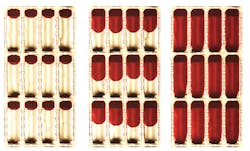DISPLAYS: Electrofluidic pixels have zero-power-grayscale operation
With their simplicity, long battery life, and readability in bright light, passive (non-self-illuminated) monochrome e-readers have carved out their own niche—and a good-sized one, too—in the vast market for electronic devices. But many people are dissatisfied with the current crop of e-readers that are based on electrophoretic displays, because they appear grayish rather than white (although this is being improved); they have a very low refresh rate, making video impossible; they have no grayscale states; and they flash a black page between refreshes—all consequences of the electrophoretic technology.
There are several new passive-display approaches being worked on. One that looks particularly promising is an electrofluidic display in development at the University of Cincinnati and Gamma Dynamics (both in Cincinnati, OH), which has three sterling qualities in one device: white-as-paper white state, video-rate potential, and zero-power grayscale operation. The last is important because there are other existing electrofluidic displays that can display grayscale tints, but only when a voltage is continuously applied, draining the battery.
Held by hysteresis
The Cincinnati display is based on electrowetting (EW), in which an applied electric field changes the contact angle of a liquid pigment drop on a solid substrate, forcing the drop to change position between two reservoirs, one exposed to the viewer and the other one hidden (the pigment actually displaces a second immiscible clear liquid). Unlike other EW variants, the droplets in this display's pixels, when shifted to a partially visible grayscale position, stay in place when the power is turned off (see figure). This is achieved because contact-angle hysteresis, in which small applied forces merely change the contact angle and don't move the droplet, results in a threshold voltage for movement.
The pixels in the prototype array are 0.45 mm in size and were created from thin layers that were added one at a time, with some of the layers photolithographically patterned. The pixels were dosed with a red pigment and a clear liquid through a self-assembly technique; last, the clear top plate, which had a clear electrode and served as the EW substrate, was added.
Even though the drop-stabilizing hysteresis produces a drag force, the prototype reaches a pixel-refresh rate of 6 Hz; scaling the pixels down to a 0.15 mm size should boost the refresh rate to 50 Hz, say the researchers.
The measured white-state reflectivity approached 75%, or as bright as white paper, but the dark state reached down only to 25%, producing a poor contrast ratio. However, many things in the proof-of-concept device are nowhere close to optimum. For example, between the pixels is a light-reflective area that could be darkened; materials could be better index-matched; and colors of pigments and lower pixel layers could be appropriately lightened or darkened. These improvements are indeed being pursued, says Jason Heikenfeld, associate professor and director of the Novel Devices Laboratory in the School of Electronics and Computing Systems, U. of Cincinnati. He notes that carbon-black (a very dark pigment) is used for most of their work; the red pigment for this particular experiment was a "student's preference when he pulled it off the shelf."
E-paper, e-labels
Heikenfeld sees a need for basic web-browsing capability in monochrome e-readers and other e-paper displays—thus the push for video refresh rates. Also perfect for e-readers are zero-power grayscale images: This is easy to understand when you imagine a page containing text and photos that might be viewed for a minute before switching to the next page. Power is consumed only during switching, which lasts on the order of one-thousandth the time of viewing.
But more immediately, Heikenfeld sees potential in the use of his technology for electronic shelf labels—a huge market, he says.
Note, while the work that went into this zero-power-grayscale device is targeted at making the brightest possible monochrome display, the University of Cincinnati and Gamma Dynamics have also been working on a full-color electrofluidic display (see "Electrofluidic display uses brilliant color pigments," Laser Focus World, July 1, 2009).
REFERENCE
1. S. Yang et al., Appl. Phys. Lett., 97, 143501 (2010).

John Wallace | Senior Technical Editor (1998-2022)
John Wallace was with Laser Focus World for nearly 25 years, retiring in late June 2022. He obtained a bachelor's degree in mechanical engineering and physics at Rutgers University and a master's in optical engineering at the University of Rochester. Before becoming an editor, John worked as an engineer at RCA, Exxon, Eastman Kodak, and GCA Corporation.
